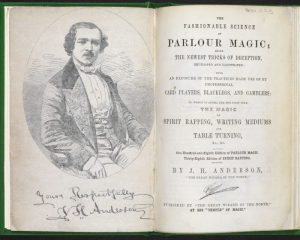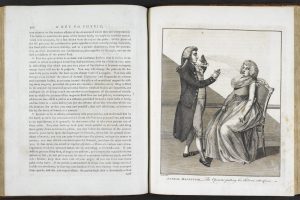 Shortly before the Women’s National Book Association was founded, Victorian culture struggled to reconcile two very different worldviews: science and belief. Astonishing developments in science, medicine, and technology had advanced Victorian society at a breakneck pace, and Victorians turned to the supernatural for explanations. Their efforts to reconcile science and belief created pop culture phenomena—including seances and ouija boards—and inspired new occult literary movements such as the Victorian Ghost Story and the Victorian Gothic.
Shortly before the Women’s National Book Association was founded, Victorian culture struggled to reconcile two very different worldviews: science and belief. Astonishing developments in science, medicine, and technology had advanced Victorian society at a breakneck pace, and Victorians turned to the supernatural for explanations. Their efforts to reconcile science and belief created pop culture phenomena—including seances and ouija boards—and inspired new occult literary movements such as the Victorian Ghost Story and the Victorian Gothic.
As we approach the Centennial celebration and our own Halloween festivities this Friday the 13th, let’s take a look back at the passionate belief in the supernatural that gripped Victorian culture and colored the literary landscape before the WNBA was formed.

Courtesy of Victorian-Era.org
A popular book on parlour magic and the art of seances.
Every aspect of Victorian society was saturated with the idea of the supernatural, including medicine. Mesmerism, the belief that fields of animal magnetism constantly flowed between bodies, first gained popularity in the 1830s and 1840s. Mesmerists placed their patients in deep trances and manipulated the magnetic fields between healthy bodies and the patient, essentially recharging them. Though the practice may sound far-fetched to many modern ears, Victorians considered Mesmerism deeply scientific, and it was championed by prominent public figures like Charles Dickens.
Facing the Industrial Revolution and the threatCharles Darwin’s Origin of Speciesposed to Christian doctrine, Victorians applied the scientific method to the afterlife, seeking proof that the soul lived on after death.Spiritualism fulfilled that need, offering Victorians the chance to commune with the deadthrough

Courtesy of The Guardian
A scene from the 1922 film Dr. Mabuse the Gambler depicting a seance with a female medium.
theatrical seances with professional (often celebrity) mediums. Mediums, who were almost exclusively women, treated participants to wild feats of levitation, table turning, automatic writing, and trances. Women were understood to have delicate natures that were uniquely sensitive to the supernatural, a belief that afforded women a place of prominence in Victorian culture when it came to the metaphysical. This esteem opened new space for women writers (including Margaret Oliphant, Vernon Lee, and Edith Wharton) in the literary scene, as women were thought to be the only legitimate writers of a newly popular genre of fiction: the supernatural tale.

Courtesy of The British Library
A woman is placed in in a mesmerist trance by her doctor. Illustration taken from A Key to Physic, and the Occult Sciences by Ebenezer Sibly
Rather than dismiss the supernatural as pure belief, Victorians approached it as a new field of scientific research. In the late nineteenth century, the Society of Psychical Research and the Theosophical Society were founded, both of which studied Mesmerism and Spiritualism with increased scientific rigor. Given the astonishing developments of the day, Victorians viewed the study of the occult as a natural expansion of the psychological and psychoanalytic sciences (Sigmund Freud, for example) that were popular at the time.
The Victorians bridged the clash between science and belief with their passionate study of the occult, and their most iconic symbols—ouija boards, seances, and ghosts—still feature in contemporary pop culture. Iconic literary movements such as the Victorian Ghost Story and the Victorian Gothic also emerged, permanently shaping the literary landscape.
If you’re interested in learning more about literature in 1917, check out our previous Centennial blog posts on war poetry and bestselling fiction!




